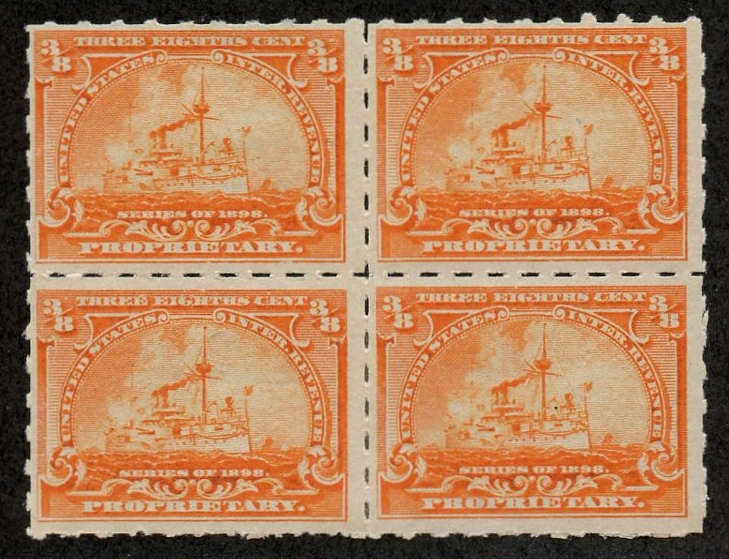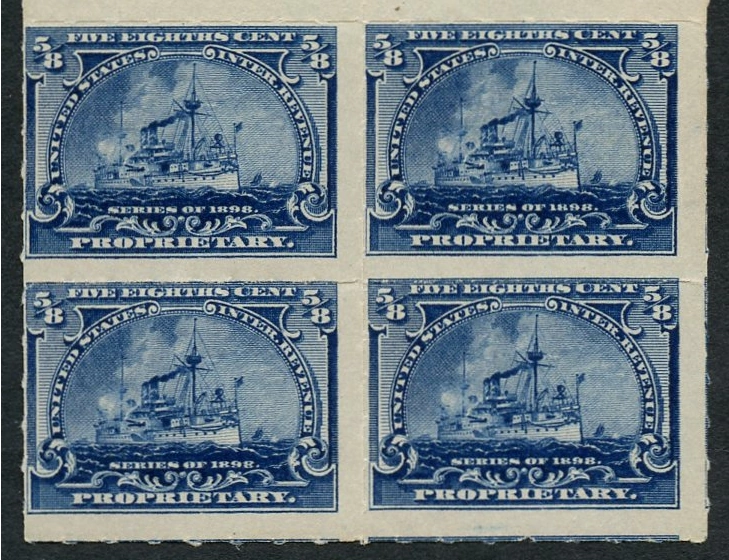A number of years ago I became interested in the variety and number of different cancellations that are to be found on the U. S. Revenue proprietary stamp issues RB20-RB31, a.k.a. the Battleship issue. As I began collecting this issue, I needed a means to keep track of the examples that I had so that I could avoid unnecessary duplication. If the "cataloging" was as simple as tracking the Scott catalog number, it's a no-brainer (only 12 issues in two distinct perforation formats, hyphen-hole and roulette). However, when you throw in that there are literally 1000's of proprietary vendors each with unique, and sometimes multiple, cancel varieties, the task becomes more of a challenge. This website was created so that I could easily track and query my inventory when at various stamp shows and as a means to view and enjoy my collection. Hopefully what I have captured here will enrich the body of material on this interesting issue and be of value to others as well.
In 1862, the United States (the "Northern states", The Union), in order to help finance the Civil War effort, authorized a tax against certain goods, services, and legal activities. Businesses subject to the tax were required to affix a 'revenue stamp' to their product to indicate that the necessary tax was paid for that item. Printing of first, second, and third issue versions of these revenue stamps occurred from 1862-1872. In 1881, the Proprietary Medicine Manufacturers and Dealers Association began pressuring congress to repeal the Civil War Tax and taxation on proprietary medicines was finally halted in 1883.
On the fateful evening of February 15, 1898, the USS Maine sank in Havana Harbor following an explosion. While there were conflicting beliefs at the time on the cause of the explosion, America declared war with Spain on April 25th. Just as "Remember the Alamo" became the rallying cry to unite the American people during the Mexican American war and the independence of Texas, "Remember the Maine" became the rallying cry for the Spanish-American war in remembrance of the sailors killed when the USS Maine exploded and sank.
Eventhough the United States Congress had repealed the revenue tax in 1883, they were aware that the tax was very successful in raising revenues for the Civil War. With new hostilities underway against Spain, Congress knew there would be a need for revenues to support this new war effort and the War Revenue Tax Bill was enacted in June of 1898. In a rush to print and issue new revenue stamps quickly, the Bureau of Printing and Engraving did not have time to design and engrave a new issue so they used an existing design, that of Admiral Dewey's cruiser that was involved in the battle of Manilla Bay earlier that year. Two designs were issued, one for proprietary use and one for documentary use.
First date of issue was July 1st, 1898 and the tax was repealed effective July 1, 1901 for the drug trade. Some taxes remained until early 1902.
As previously mentioned there were two variants in perforation for this issue: Hyphen-hole and Roulette. A good reference for the difference in these perforation types can be found on 1898 Revenues: Perforation Types. For reference on this site, I have the below illustrated examples. Identification is simplified when the stamps are in multiples as the perforations are more easily distinguished.


Cancels can be either Printed or Handstamped. While Printed cancels are generally more striking and easier to read, there are a number of Handstamped cancels that are truly impressive in their design and intricacy. One should remember that these stamps were issued more than 120 years ago and often placed on product packaging. The stamps were not of much importance to the consumer of the product. For this reason, tears, creases, holes and other defects are common. Similarly, for the issuing business, the cancel was not always deemed too important. While some businesses used the cancel as an opportunity to further "advertise" their business or product, these instances are less common than the total number of businesses who simply met the requirement of having the revenue stamp attached to the product and cancelled. With specific regards to Handstamped cancels, the process to cancel the stamp was imprecise with poor inking, poor centering, and poor strikes being common. Likewise, for both Handstamped and Printed cancels, the choice of ink color for the cancel is sometimes a poor choice or option. For example, the use of a violet ink for the cancel of RB25 (dark purple color design) often makes the reading and identification of the cancel difficult. For the collector, all of these conditions make collecting examples of the cancels a challenge. The unfortunte aspect is that some examples presented here are poor examples of the cancel.
Valuation of any stamp is somewhat subjective. Quality and rarity factor into the equation but one element is simply the market for that specific stamp and what someone is willing to pay for that specific stamp. Given the vast quantity of varieties to the cancellations within this issue, catalog value is virtually meaningless. Is it possible to find issues for sale at or below catalog value? Yes. However, the majority of examples will sell for a markedly higher cost. Presented here are the 2006 catalog values (yeah, I'm not current) for sound copies of this issue excluding any factor the desirability of the cancellation. Keep in mind what the Scott catalog states: "Printed cancellations on proprietary stamps command sizable premiums".
| Roulette 5 1/2 | Hyphen Hole Perf 7 | |||||
|---|---|---|---|---|---|---|
| Scott | Description | Unused | Used | Unused | Used | |
| RB20 | 1/8c | yellow green | .20 | .20 | .20 | .20 |
| Block of 4 | .50 | .50 | .75 | .70 | ||
| RB21 | 1/4c | brown | .20 | .20 | .20 | .20 |
| Block of 4 | .50 | .25 | .55 | 1.00 | ||
| RB22 | 3/8c | deep orange | .25 | .25 | .30 | .25 |
| Block of 4 | 1.10 | 1.00 | 1.40 | -- | ||
| RB23 | 5/8c | deep ultra | .25 | .25 | .30 | .25 |
| Block of 4 | 1.25 | 1.10 | 1.50 | 1.25 | ||
| RB24 | 1c | dark green | 2.10 | .25 | 26.00 | 13.00 |
| Block of 4 | 10.50 | 1.10 | 140.00 | 67.50 | ||
| RB25 | 1 1/4c | violet | .25 | .25 | .30 | .25 |
| Block of 4 | 1.10 | 1.00 | 1.40 | 1.25 | ||
| RB26 | 1 7/8c | dull blue | 12.00 | 1.60 | 32.50 | 7.75 |
| Block of 4 | 57.50 | -- | 160.00 | -- | ||
| RB27 | 2c | violet brown | 1.10 | .25 | 6.25 | .80 |
| Block of 4 | 5.00 | -- | 27.50 | -- | ||
| RB28 | 2 1/2c | lake | 4.25 | .25 | 5.25 | .30 |
| Block of 4 | 21.00 | 1.10 | 29.00 | -- | ||
| RB29 | 3 3/4c | olive gray | 42.50 | 10.50 | 72.50 | 21.00 |
| Block of 4 | 210.00 | -- | 350.00 | 110.00 | ||
| RB30 | 4c | purple | 13.00 | 1.10 | 62.50 | 18.00 |
| Block of 4 | 62.50 | 5.50 | 325.00 | 90.00 | ||
| RB31 | 5c | brown orange | 13.00 | 1.10 | 67.50 | 21.00 |
| Block of 4 | 62.50 | 5.75 | 350.00 | 175.00 | ||
The information contained in this site is focused on the 1898 Battleship Proprietary issues (RB20-RB31) and their cancellations.
As already stated, the main driver for this site is so I can more easily track and enjoy those issues that I have in my collection.
Here you will find several methods of locating issues and example cancellations in the collection.
I have used two primary reference sources for identification of the cancellations. The first being American Revenue Association, PROPRIETARY REVENUES OF 1898 PRECANCELED VARIETIES, commonly referred to as the Chappell-Joyce List and the second is the Battleship Desk Reference by Mustacich and Giacomelli. Each of these reference materials attempts to identify variations within the classification of the cancellations. The cancel type is only specific to Chappell-Joyce as the on-line version of the Battleship Desk Reference now shows images, and as they say, a picture is worth 1,000 words. Additionally, because the Chappell-Joyce type is presented in a narrative versus a shorthand notation like the BDR uses, there will be a (more) link where not only the narrative may be viewed but also any differences between the Chappell-Joyce method and the Battleship Desk Reference method for type classification.
Of specific note, I do borrow the shorthand notation methodology
described in the Battleship Desk Reference (BDR) as well as using this resource as a means to define sub-types for a
given proprietary merchant.
With regard to the shorthand notation, each issue/cancel variety will be shown with this notation to aide in categorization of
the cancel variety.
Although many examples in the collection and depicted here have been purchased from various dealers, both on-line and at various
stamp shows, many of the finer examples and more scarce cancellations have been acquired from the following:
For issues from either the Walter J. Orton III or the Robert Mustacich collections, these issue examples will be shown with an ex-[name] to indicate their source.
Mr. Orton received gold awards for his Proprietary “Battleship” Revenue Stamps of 1898 from Alpha to Omega exhibit, which included the only known set of large die proofs in private hands. He acquired these through private treaty from the The Morton Dean Joyce Collection of United States Revenue Stamps. His exhibit, in its entirety, was purchased by Richard Friedberg.References